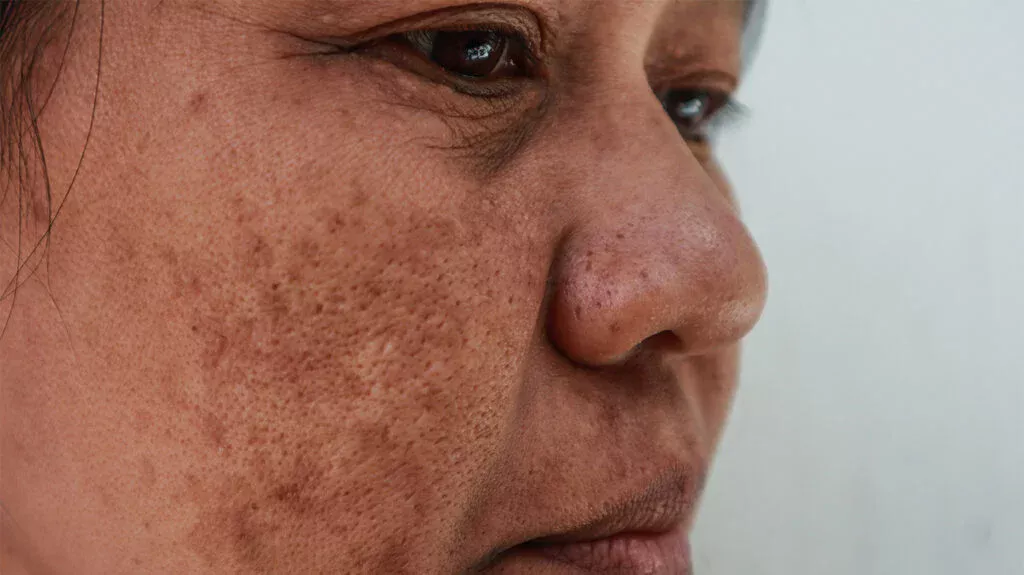Understanding Melasma
Melasma, also known as the “mask of pregnancy” or chloasma, is a skin condition characterized by bluish-grey or brown patches or freckle-like spots typically found on the cheeks, forehead, upper lips, and forearms. This harmless condition occurs when melanocytes, the cells responsible for skin color, overproduce melanin in response to heat, hormonal changes, light, or ultraviolet radiation, leading to skin darkening.
Often seen in pregnant women, melasma can vary in intensity, becoming darker in summer and lighter in winter. While it poses no health risks, it can affect one’s self-confidence and cause self-consciousness. Understanding the nature and triggers of melasma is essential for effective management and treatment.

Common sites affected by melasma
Melasma is commonly seen on one’s face, affecting the cheeks, nose, upper lip, and forehead.
It sometimes affects the arms, neck, and back.
Melasma can affect any part of one’s skin exposed to sunlight, and that is why most people with melasma notice their symptoms getting worse during the summer months.
How common is melasma?

About 15% to 55% of pregnant women get melasma.
2% to 35% of the population may get this condition, which can happen during a woman’s reproductive age, rarely seen during puberty.
The common age of occurrence is 20 to 40.
High-risk individuals with melasma:

- People with brown to dark brown skin are affected more as compared to fair skinned people.
- Out of 100%, 90% of the affected sex is female.
- It affects only 10% of males.
- Also, one is at risk if they are on oral contraceptives or hormones.
Types
There are three types of melasma:
- Epidermal: has a dark brown colour and a well defined border. It responds well to treatment sometimes.
- Dermal: has a light brown to bluish colour, a blurry border, and doesn’t respond well to treatment.
- Mixed melasma: is the most common type. It has both brown and bluish patches and shows some response to the treatment.
Causes

The two main causes of melasma are radiation and hormones.
UV (ultraviolet) and infrared radiations from the sun top the list for making melasma worse.
Other causes include:
- Anti seizure medication
- Contraceptive therapy
- Estrogen/Diethylstilbestrol
- Hypothyroidism
- LED screens
- Pregnancy
- Genetics
- Hormones
- Cosmetics
- Phototoxic drugs (medication that makes one sensitive to sunlight)
- Scented soaps
- Tanning beds
What medicines help in the treatment of melasma?

Be regular with applying sunscreen containing iron oxides and a SPF of 30–50 reapplied every two hours.
Topical therapy using tyrosinase inhibitors prevents formation of new pigments by stopping the formation of melanin (the dark colour).
Examples of tyrosinase inhibitors and other types of agents that are helpful include:
- Azelaic acid (pregnancy safe)
- Cysteamine
- Hydrocortisone
- Hydroquinone
- Methimazole
- Soybean extract
- Topical alpha-hydroxy acid
- Tranexamic acid
- Tretinoin (contraindicated/can’t be used in pregnancy)
The combination of tretinoin, hydroquinone and a moderate topical steroid has shown the best effect on melasma.
Other helpful agents
- Runicol
- Zinc sulfate
- Absorbic acid (vitamin C)
- Arbutin
- Deoxyarbutin
- Glutathione
- Kojic acid or kojic acid dipalmitate.
- Licorice extract.
- Mequinol.
- Resveratrol.
FAQs
Why does Melasma occur in pregnancy?
In pregnancy, women have increased levels of the hormones progesterone and estrogen that contribute to melasma. The colour usually fades away after pregnancy.
Is there a cure for Melasma?
Unfortunately, melasma is hard to treat. To determine a treatment plan, your dermatologist has to first figure out what’s possibly causing your melasma.
Depending on the person, melasma may go away on its own.
It can be permanent, or it may respond to treatment within a few months. Most cases of this condition fade away with time and with good protection from sunlight.
Is Melasma cancerous?
No, melasma is not cancerous.
However, there are some skin cancers that can mimic melasma, so seeing your dermatologist is recommended if you see melasma-like symptoms to confirm the correct diagnosis.
Is Melasma permanent?
Melasma is a chronic disorder. This means it’s long-lasting (three to four months or more). Some people have melasma for years or their entire lives, and others may have melasma for a short time, like during pregnancy.
Is Melasma painful?
No, melasma is completely harmless. It’s not itchy, painful, or uncomfortable in any way.
Will Melasma go away after I give birth?
Melasma will likely fade away within three to four months after you are no longer pregnant.
Want to read more like this one? Visit the HomePage



